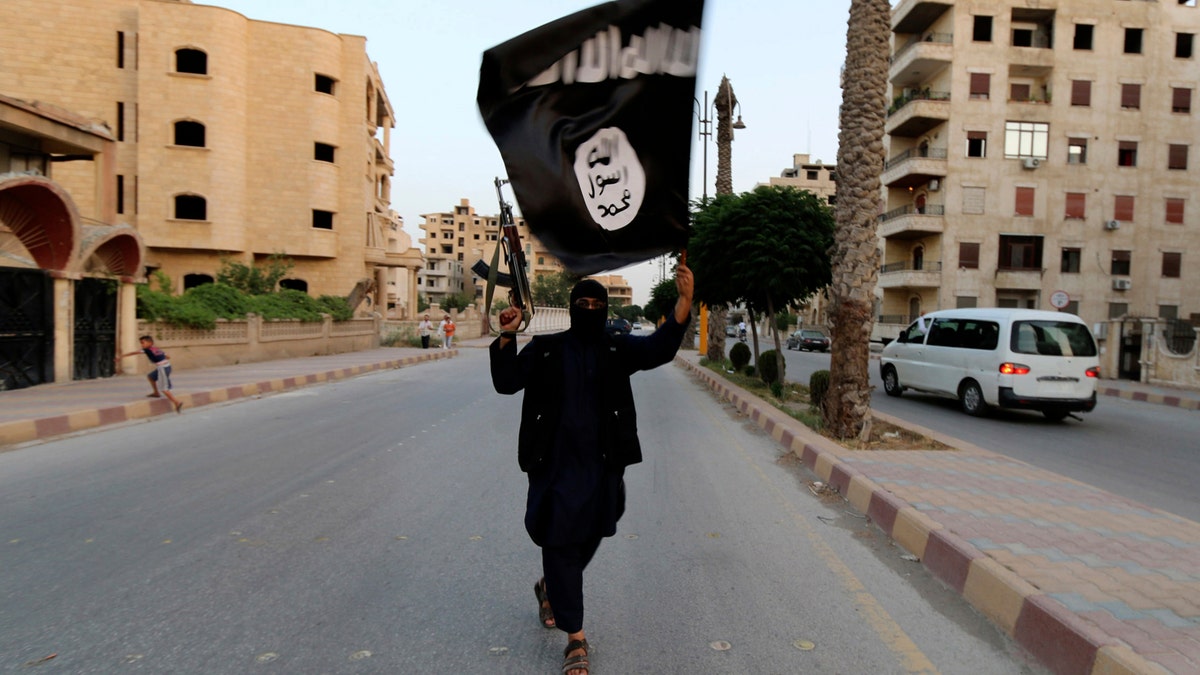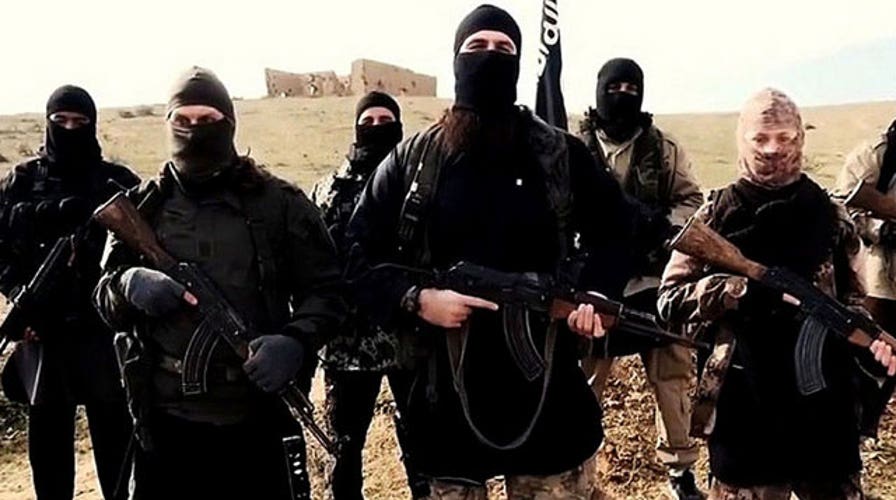In January the U.S. Central Command announced that U.S. and coalition airstrikes against Islamic State targets in Iraq and Syria destroyed some 184 Humvees, 58 tanks and nearly 700 other vehicles. The number of ISIS military vehicles destroyed may seem significant, but is really just a drop in the bucket compared to the militants' overall firepower.
While specific numbers are difficult to come by, reports suggest that ISIS has a huge fleet of vehicles – including tanks - its possession. Last year, for example, the jihadists captured 2,300 Humvees from Iraqi forces when they captured the city of Mosul, some of which were then converted to armored vehicles.
Unlike traditional nation states ISIS doesn't produce tanks or other weapons in factories, and unlike past insurgent forces that were supported by a nation state ISIS isn't being armed or equipped by a major power either. Yet the group's fleet of vehicles continues to grow. In May ISIS captured U.S.-built equipment, including M1A1 tanks after the group took control of the town of Ramadi, 60 miles west of Baghdad. The militants’ haul reportedly included about 100 wheeled vehicles and dozens of tracked vehicles.
Related: Historic tanks in pictures
There should be concern that ISIS has become so well armed, experts warn. In addition to modern military hardware, militants have also captured Cold War-era weaponry from Syrian forces. The nation was supported throughout the Cold War by the Soviet Union and built up vast quantities of Warsaw Pact armaments. Today those weapons – everything from AK-47 assault rifles to T-72 main battle tanks – are being utilized by all sides in the ongoing Syrian Civil War.
"Syrian rebel groups probably make the most extensive use of heavy equipment at the moment, thanks largely to battlefield successes," Jeremy Binnie, Middle East/Africa Editor for IHS Jane's Defence Weekly, told FoxNews.com. "But that is also a product of the Syrian military's vast inventory of Soviet-era weapons and equipment, (as well as) its inability to destroy this materiel after it has been captured."
Many of these Syrian rebels likely served in the military at some point and this may provide them with the knowledge to operate and, more importantly, maintain the equipment.

File photo - A member loyal to the Islamic State waves an ISIS flag in Raqqa June 29, 2014. (REUTERS/Stringer)
There is a growing concern that these weapons have allowed groups to operate more like an actual army than merely as insurgents. This has enabled them to take and actually hold ground. ISIS has not only tanks but towed field guns and artillery pieces, which allow the group to conduct shelling against Iraqi military targets from a great distance; as well as fixed anti-aircraft guns and even shoulder-mounted anti-aircraft weapons. Each of these presents serious problems. While the fixed anti-aircraft guns threaten coalition aircraft, shoulder-mounted anti-aircraft weapons could take down a commercial airliner.
"Rocket-fired grenades and shoulder-launched missiles have long been available in black markets in the Middle East and Africa, but this higher-end stuff is coming from other sources," Seth Jones, director of international security and defense policy center at the RAND Corp. told FoxNews.com. "This really shows that conventional weapons are a reason for concern. In many ways we're largely past the stage of nuclear proliferation unless it was provided by a state, and that isn't likely to happen. However, these anti-aircraft weapon systems of all sizes are still a reason for concern."
Armored vehicles are increasingly a problem as well, and one factor is that tanks – especially Soviet era ones – aren't that difficult to maintain and are difficult to destroy.
"Modest investment in an old tank can become a successful weapons platform," David Willey, curator of The Tank Museum in the U.K., told FoxNews.com. "Today's modern anti-tank weapons now cost as much as what an old tank costs on the black market, so it makes destroying a tank an expensive proposition."
Related: High-tech military gear
The cost factor is largely because western doctrine in destroying a tank is far different to the likely tactics of a rebel force. "There is the cost of flying a combat aircraft and its weapons system," Robert Farley, assistant professor at the Patterson School of Diplomacy and International Commerce, told FoxNews.com.
Rebel groups might just as easily use a gasoline bomb – much like the Finnish-devised "Molotov Cocktail" of World War II – or other IED (improvised explosive device) added Farley. It may be rare that such improvised weapons could truly take out a tank but it would certainly put the crew at risk, especially if they are not locked inside the tank.
ISIS and other rebel groups, have largely, not attempted their own aerial sorties, despite the fact that combat aircraft from Iraq and Syria have also been captured.
"There are number of reasons why ISIS hasn't taken to the sky, even as there are reports that they do have people who could fly," Farley told FoxNews.com. "In the case of Iraq there are Sunni pilots who are likely fighting with ISIS, and the group even likely has maintenance crews who could prepare the planes for flight."
However, there are logistics to overcome, including the lack of proper fuel, not to mention spare parts. There is also the fact that a single plane can only do so much.
"You drive a tank down the road, and if it breaks you still have a tank that you can repair and the crew, which can still fight," Farley added. "If you put a vintage Soviet Mig21 in the air and it crashes it doesn't make a lot of sense."
The final equation for why ISIS aircraft remains grounded is likely a psychological, according to Farley, "ISIS knows that there are American fighter jocks who want nothing more than to put an ISIS flag on the cockpit and have a combat air kill. It is quick death for anyone who gets into an ISIS plane."
In fact, ISIS is just one of several group that have built up powerful arsenals that include weapons that were typically only fielded by major powers.
"The extent to which non-government forces use heavy weapons typically depends on the level of external support they receive, the local availability of such equipment, and their ability to maintain it," Binnie told FoxNews.com. “The Polisario Front [in Western Sahara] has numerous Soviet-era armored vehicles thanks to Algerian support rather than victories over the Moroccan military.”
Related: 11 stunning F-22 fighter jet images
Other nations such as Libya and Iran have been the alleged suppliers of weapons to groups such as Al-Shabaab in Somalia and the Houthi rebels in Yemen. Since the downfall of Muammar Gaddafi large quantities of weapons have flown out of Libya and across the region. This included not only Gaddafi's vast caches of convention weapons but also small arms and other weapons intended to be used by the Libyan rebels. Now some of these weapons are reportedly in the hands of Al Qaeda-linked militants and other radicalized groups.
"It is certainly unhelpful to the west that a range of rebel groups in Africa, the Middle East and as far away as South East Asia have acquired everything from small arms to tanks," added Rand Corp.’s Jones. "It has facilitated their ability to achieve their objectives and there isn't enough emphasis that this access to weapons has given rise to rebel groups."
Al Qaeda, ISIS, Al-Shabaab and other groups certainly could have gotten weapons on the black market, but the lack of stable governments in Libya and Syria have made it easier for these groups to get armed – and with weapons past insurgents might have only dreamt of possessing.
"The collapse of the Libyan military in 2011 has allowed many of the militias in that country to obtain heavy equipment," added Binnie. "The same is true in Iraq after the military collapse in 2014, although the ISIS struggles to keep that equipment operational due to coalition airstrikes and probably a lack of spares and familiarity with U.S. equipment."
While the ISIS arsenal remains an ongoing concern for the U.S. and its allies in Operation Inherent Resolve, other shadows of the Cold War remain visible in the Middle East. The Pentagon, for example, has been warily eyeing a Russian military buildup in Syria as Moscow protects its interests in the civil-war ravaged country.

